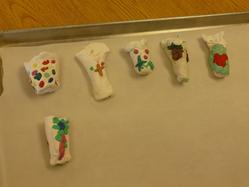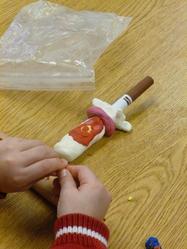The Greatest Commandment
Art Workshop
Summary of Lesson Activities:
Make a clay mezuzah. Talk about the need to always remember to love God and to spread the love of the Lord to your neighbor. [Note: All graders visited this workshop.]
For scripture, objectives, and background - see above.
Leader Preparation:
- Read the scripture for this lesson.
- Read and reflect on the overview material provided for this lesson.
- Gather the materials.
Supplies List:
- Easel; appropriate marker
- For 3rd grade and up: Bibles
- Table covers
- Dowels (3/8", cut into 5” lengths, one per child or use larger markers)
- Scissors
- Foil
- Petroleum Jelly; Disposable gloves (one pair)
- Wax paper; Ruler
- White Sculpey™ clay – 1.5 oz. per student [A 1.75 pound box yields 18 mezuzahs]
- Various colors of Sculpey™ (small quantities)
- Paper muffin cups
- Zipper sandwich bags
- Tools for working clay (optional)
- Wet wipes
- Pointed object for poking hole in clay (so that mezuzah can be hung)
- Parchment-color paper (8.5 x 11") cut in thirds (about 3.5 x 8.5").
- Sharpie marker
- Colored Pencils; Pens
Before Start of Class:
- Cover tables.
- Take a look at the sample clay mezuzah. Then put it away. Don’t show the kids! [I don’t like to show samples to kids. It tends to make them think that they have to make one that looked like the sample. Allow them to be creative.]
- Cut approximately 8” squares of wax paper, one per student.
- Place several colors of Sculpey clay in small blobs (for decorating mezuzahs). Place these blobs of clay on the paper muffin cups.
- Cut aluminum foil into strips about 2” wide by 6-7” long. Wrap the dowels with the foil.
- Wear the disposable gloves and lightly rub Petroleum jelly over the dowels so they will slide out easily from the clay.
- For 3rd grade and up: write the words “Pharisees” and Sadducees” on the easel.
- Manipulate the Sculpey until it is soft. Shape into balls about 1.5” in diameter, one per child.
Lesson Plan
Opening- Welcome and Lesson Introduction
Greet your students warmly, welcoming them to the Art Workshop. Introduce yourself and any other adults.
Begin with prayer. Ask for any prayer requests. Ask if anyone would like to lead the group in prayer. Be prepared to say a prayer yourself, working in prayer requests. Use the Lord’s Prayer as the ending.
A suggestion: “Holy One, in this time of Lent we think towards Easter. We think about how your son gave up his life for us. We think about all that Jesus taught us, especially about love. Help us to love you and to love others with all of our heart, and soul and mind. (End with everyone joining in on the Lord’s Prayer.) Amen.”
Dig - Main Content and Reflection
Ask: Do you know your neighbors?
Who are our neighbors?
Just the people who live in the next-door house or apartment?
Say: Jesus asked us to take care of our neighbors. Let’s read about where Jesus said this in the Bible, to learn about what he meant.
Ask: Where in the Bible would we read about Jesus?
What are the first four books of the New Testament?
What do we call those first four books? (the Gospels)
What does the word “Gospel” mean?
Say: The word Gospel means “good news.” Jesus teaches us the good news about God’s love for us.
For 3rd grade and up:
Distribute Bibles.
Have everyone find Matthew 22:34. Remind them of the quick way to find the New Testament. [Opening the Bible in middle lands you usually in Psalms. Taking just the back half and finding middle of that, gets you to beginning of NT.]
Have kids take turns reading verses 34-40.
[In later weeks of the Rotation, have everyone find the verse, then ask kids to tell you the story. Read verses only if needed to fill in details.]
A note about the Bibles in use for 4th- 6th graders: The Bibles in this room are all different versions. If reading takes place out of the Bibles allow the kids to notice that there are differences.
Show them that they can tell what version they are reading by looking at the spine:
NRSV – New Revised Standard Version
NIV – New International Version
TEV – Today’s English Version (also called the Good News Bible)
CEV – Contemporary English Version
NLT – New Living Translation
For 1st and 2nd graders:Read the students the following story while holding open an Adventure Bible…
Jesus was teaching the people. In this group of people were certain Jewish religious leaders called Pharisees. The Pharisees knew all Ten Commandments but they also made up more laws. They thought that their laws helped people to not break God’s laws. But instead their laws made it very hard to keep God’s law. The Pharisees didn’t like Jesus. They wanted to trick Jesus so they asked him what they thought would be a hard question.
One of them asked Jesus: What is the most important law?
Jesus replied: “Love the Lord your God with all your heart, and with all your soul, and with all your mind. And love your neighbor as you love yourself.”
For all students:
Say: So Jesus was being questioned as to what the most important commandment was. Today we are going to make a special box that can hold a written copy of that most important commandment.
Ask: Remember how last month you learned about the Ten Commandments? Do you suppose it would be hard to decide which was the most important of those ten?
Say: Jesus was simplifying the Ten Commandments. He summed them all up into two commandments.
Ask: What were those two commandments? (verse 37, and verse 39)
Say: The first one was: Love God with all you’ve got— your heart, and your soul, and your mind. The second commandment was: love your neighbor as you love yourself. These two commandments, which are both about love, we call the Greatest Commandment: Love God and love your neighbor.
Start the art project:
Say: Let’s start on our project – making mezuzahs (muh-ZOO-zuhs) out of clay.
Distribute rolling pins and pieces of wax paper.
Demonstrate rolling out a ball of clay into a rectangular shape, no more than ¼ inch thick; Stress putting pressure on the rolling pin; that the rectangle should be even in thickness, and about 5-6” long. [You and the Shepherd will have to help the younger students. You may decide to roll out the clay ahead of time for this group?]
Distribute balls of clay.
When sheets of clay have been rolled…
Demonstrate how to wrap your sheet of clay around the foil-covered dowel. The dowel will not stay in the mezuzah. It just gives the mezuzah shape while working on it. Close the bottom of the mezuzah but leave the top open. The mezuzah may have a tapered bottom or be square.
Discussion: (while the students are working)
Say: Mezuzahs are containers; they contain a special scripture. This scripture is written on a scroll – a rolled up piece of paper. This small scroll contained the following verse from Deuteronomy, called the Shema. See if you recognize this verse… “Hear, O Israel: The LORD our God, the LORD is one. Love the LORD your God with all your heart and with all your soul and with all your strength.”
Ask: Did you recognize that verse?
Say: This is the scripture that Jesus quoted in the New Testament and the one he called the greatest commandment!
Demonstrate how to break off bits of the colors of clay and apply them to the mezuzah as decorations. These decorations can be flat or 3-D. Not very much clay is needed. Try not to add too much to the thickness of the mezuzah.
TAKE NOTE!
Say: Mezuzahs were put up on the doorframe of Jewish homes – both in Jesus’ day and today. Because this is a Jewish tradition, it would likely be offensive to Jews if they saw a mezuzah with a cross on it.
Say: Every time the Jewish people go in or out of their house they would touch the mezuzah as a reminder. The purpose of the mezuzah is to remind you to love the Lord your God and spread the love of the Lord to your friends and family.
Do: Instruct the children in saying the key Bible verse.
Say: This is what we’ll put into our mezuzah’s – our key Bible verse. If you have time you may write your key verse out. [Provide paper and colored pencils.] Otherwise we will provide a slip of paper with the key verse written on it.
[If a student writes out their own verse, have them copy it out of the Bible. Write lightly in pencil their name somewhere on the paper. Collect these to distribute next week with the mezuzahs.]
Ask: Why do you suppose God emphasized loving him with all we’ve got - our heart, our soul and our mind?
How is loving God related to loving other people?
MAKE SURE that you write the student’s name on the back of their mezuzah using the Sharpie marker.
Other Discussion Points:
- Mezuzahs can be made of ceramics, wood, metal, glass, clay etc.
- Discuss different ways to love our neighbor.
Closing:
Ask: Why do Jewish people hang a mezuzah in their home?
Where do you suppose you’ll hang your mezuzah in your home?
Say: Talk to your parents about where to hang it. Explain to them the meaning of a mezuzah. Perhaps you’ll take home your mezuzah and hang it outside your bedroom door.
Cleanup:
Put a hole in the top of each mezuzah to allow it to be hung up.
Bring up a cookie sheet from the kitchen and a piece of parchment paper. Place the mezuzahs on the parchment-covered sheet, removing the dowels. Bake as directed.
Throw out (recycle?) the foil on the dowels. Save the dowels for next week.
Resources:
Derden, Jaymie. “Bible Blast-off! Art Workshop.” G.R.E.A.T. Adventure Dream Team at State Street United Methodist Church, Bristol, VA. 2007. Wood, Eileen Chadis. “Clay Mezuzahs.” 2008. http://www.chadiscrafts.com/fun/claymezuzah.html
A lesson written by Carol Hulbert for First United Methodist Church, Ann Arbor, MI
Copyright 2008 First United Methodist Church, Ann Arbor, MI.
Permission to copy materials granted for non-commercial use provided credit is given and all cited references remain with this material.
Photos copyright, Carol Hulbert.
A representative of Rotation.org reformatted this post to improve readability.




